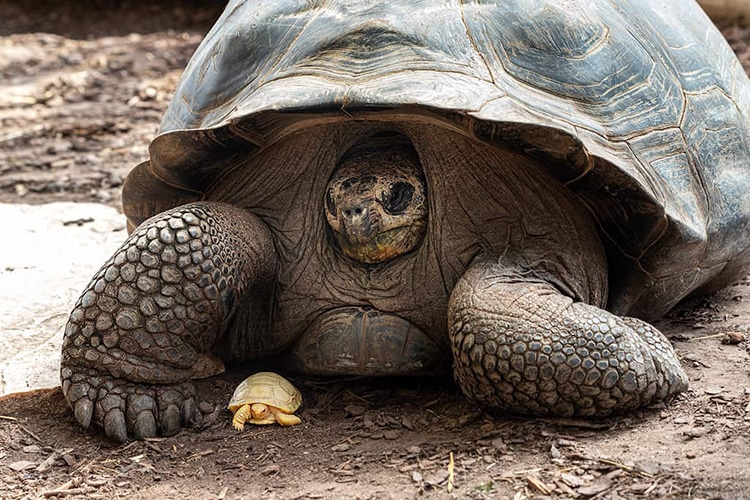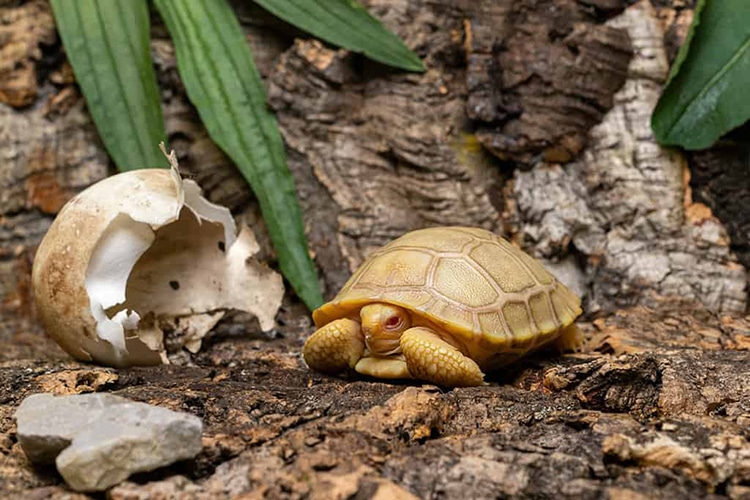
Photo: Tropiquarium
The Galápagos giant tortoise (Chelonoidis niger) is an incredible species. The massive reptiles can live well over a century and are native to the unique environment of the Galápagos Islands. These living relics can weigh over 500 pounds and are difficult to breed. Optimistic estimates put their numbers at 10,000 to 15,000 tortoises alive today in the wild. While these creatures are already rare, a tiny baby tortoise has been born at a Swiss Zoo with albinism, making it an even greater rarity.
The Tropiquarium, a zoo in Servion, Switzerland, is to be congratulated for the arrival of the new addition. Eggs were laid by a 220-pound female on February 11, and then the two babies hatched on May 1 and May 5, respectively. Both weighed 1.8 ounces at birth. They were whisked away to be warmed in an incubator for a month. They have just now made their debut. Only one of the two has albinism, a genetic condition which prevents the production of melanin. The itty bitty reptile has a white shell, white skin, and red eyes (due to visible blood vessels).
“We were surprised to discover an albino baby,” zoo staff said in a statement. “This is the first time in the world that an albino Galápagos tortoise has been born and kept in captivity.” None have been recorded in the wild either. Zookeepers suspect albinism may appear in 1 in 100,000 tortoises, although this is speculative. The gene is recessive, so tortoises may carry it without anyone knowing. Two recessive genes must combine to appear visually.
The babies are a brilliant addition to the zoo, but they are remarkable for many reasons. The Galápagos giant tortoise is an aggressive mate, with much biting involved. When babies are born in the wild, the males and females are initially indistinguishable. However, warmer conditions during incubation produce females, while cooler temperatures produce males. These young creatures also mysteriously vanish for the first five years of their life. It is surmised they shelter under debris on their island home, hiding from predators. Around five years old, they suddenly emerge, too big for hawks to carry away.
It is unsure exactly how long the new baby tortoise might survive, as albinism can inhibit the survival mechanisms of an animal by making them more vulnerable to predators and sunlight. However, the unique creature and its sibling are part of an important mission to save a species under extreme pressure. It is unclear how global warming may affect the gender ratio among the tortoises, but it is certain that global warming will pose challenges for the species. The birth of the baby turtles is, therefore, to be celebrated.
A baby Galápagos giant tortoise with albinism was born at a Swiss zoo.

Photo: Tropiquarium
This 1 in 100,000 rare event is to be celebrated both for its uniqueness and its importance for a species under pressure.

Photo: Tropiquarium
h/t: [Live Science]
Related Articles:
Photographer Captures Rare Glimpse of Siberian Tiger in Its Natural Environment
San Diego Zoo Celebrates First Male Golden Takin Calf Born in Western Hemisphere
California Condors Return to the Redwoods After a Century’s Absence
Adorable Litter of Endangered Red Wolf Pups Give Hope for Future of At-Risk Species
